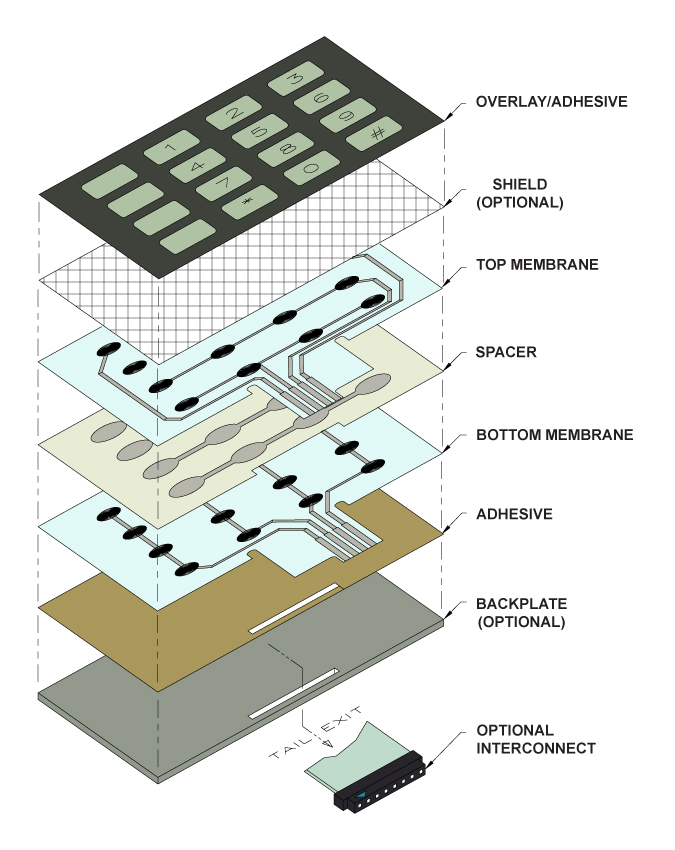How to Make Sure Longevity and Integrity with a High-Quality Membrane Switch
How to Make Sure Longevity and Integrity with a High-Quality Membrane Switch
Blog Article
Comprehending the Performance of Membrane Layer Changes for Individual User Interface Instruments
The performance of membrane switches stands for a substantial development in customer interface layout, incorporating effectiveness with visual versatility. As industries progressively prioritize individual experience, understanding the subtleties of membrane layer switch modern technology ends up being necessary.
What Are Membrane Buttons?
Membrane switches are cutting-edge user interface gadgets that help with user communication with electronic devices. These versatile elements contain numerous layers, consisting of a graphic overlay, spacer, and a published circuit layer. The layout enables a smooth combination into various electronic devices, boosting both the aesthetic and useful elements of customer interfaces.
Membrane layer switches are generally utilized in a variety of applications, from home home appliances to industrial machinery and clinical tools. Their building usually includes a slim profile, making them an ideal choice for compact layouts. The responsive feedback offered by these buttons can be crafted to meet specific user choices, guaranteeing efficient interaction in between the user and the device.
Sturdiness is one more considerable benefit of membrane switches, as they are immune to dust, dampness, and chemicals, which improves their life-span in requiring environments. Furthermore, these buttons can be tailored in regards to shape, dimension, and graphic design, enabling branding and user-specific functions. Overall, membrane switches over represent a functional solution for enhancing user experience in digital tools, incorporating capability with aesthetic appeal in a reliable fashion.
Just How Membrane Layer Switches Over Work
Operating on a straightforward concept, membrane layer switches over use a split building to register user input efficiently. Each switch includes multiple layers, consisting of a published circuit layer, a spacer layer, and a top graphic layer, which are designed to function together seamlessly. When a customer presses the top layer, it presses the spacer layer, bringing the conductive components of the circuit layer right into call with each various other.
This get in touch with develops a closed circuit, indicating the tool to carry out a certain feature. The layout permits for different configurations, including tactile responses, which can enhance the customer experience by providing a physical feeling upon activation. The materials utilized in membrane layer switches typically consist of adaptable substrates, such as polyester or polycarbonate, which guarantee longevity and resilience against deterioration.

Key Benefits of Membrane Layer Buttons

Another substantial benefit is their compactness. Membrane layer switches are thin and light-weight, which allows producers to conserve area in their devices without sacrificing functionality. This attribute is especially beneficial in applications where weight and quantity are essential considerations.
Additionally, membrane layer buttons are resistant to dirt, wetness, and chemicals, boosting their toughness. This resilience expands their lifespan and lowers the need for constant replacements, visit our website leading to cost savings with time.
Furthermore, the responsive feedback supplied by membrane switches can be maximized to enhance individual communication. They can include functions such as elevated buttons or audible clicks, boosting usability and individual experience.
Applications Throughout Industries
Interface gadgets making use of membrane layer switches are common in a wide selection of markets, showcasing their flexibility and performance. Membrane Switch. In the medical field, membrane switches are indispensable to gadgets such as analysis devices and person tracking systems, where their sturdiness and convenience of cleaning are essential for preserving health criteria. In the auto industry, these switches are utilized in control panel controls and infomercial systems, supplying a smooth and modern-day interface for individuals.
Moreover, the consumer electronic devices field take advantage of membrane buttons in appliances and portable tools, where compact style and straightforward interfaces enhance individual experience. Industrial applications additionally leverage membrane changes for control panels in equipment and automation systems, stressing their effectiveness and resistance to harsh environments.
In the aerospace and protection markets, membrane layer buttons are used in cockpit controls and equipment, where integrity and efficiency under severe problems are extremely important. In addition, the video gaming market progressively includes membrane layer switches in controllers and gallery makers, contributing to an engaging user experience. Overall, the versatility of membrane layer switches allows their widespread usage across many fields, highlighting their significance in modern-day interface design.
Future Fads in Membrane Switch Over Innovation

Furthermore, using sophisticated products, such as polycarbonate and polyester films, is anticipated to rise, offering improved durability and resistance to environmental stress factors. These materials find add to the total durability of membrane layer buttons, making them ideal for harsher industrial applications.
Furthermore, the consolidation of clever modern technology, including IoT connection, will certainly allow membrane buttons to communicate with other devices and systems, facilitating an extra interactive customer experience. This fad aligns with the growing need for clever our website tools throughout numerous industries, from health care to consumer electronic devices.
Last but not least, customization options are anticipated to broaden, enabling makers to produce bespoke services tailored to details user demands and preferences. These developments will certainly place membrane layer buttons as crucial components in the development of customer interface technology.
Final Thought
In conclusion, membrane changes represent an essential improvement in customer interface innovation, providing a trustworthy and flexible option for varied digital applications. As advancements in product scientific research and touch noticing modern technologies continue, the performance and applicability of membrane buttons are anticipated to broaden, enhancing their significance in contemporary electronic tools.
Report this page